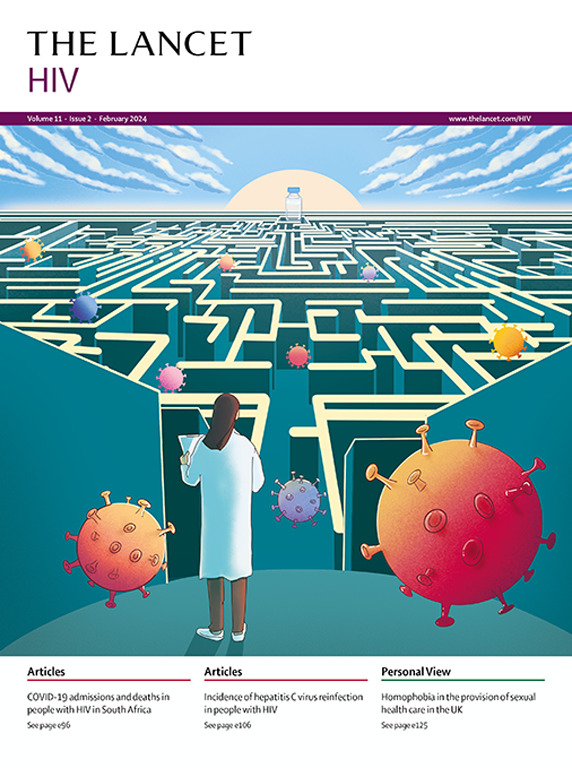Probability of vertical HIV transmission: a systematic review and meta-regression.
IF 13
1区 医学
Q1 IMMUNOLOGY
引用次数: 0
Abstract
BACKGROUND Eliminating HIV vertical transmission is a global priority and monitored by estimating paediatric HIV infections with the UNAIDS-supported Spectrum AIDS Impact Module (Spectrum-AIM). Recent innovations in antiretroviral therapy (ART) service-delivery models and first-line regimens aimed to reduce vertical transmission probabilities. We did a systematic review and meta-analysis to estimate vertical transmission probabilities by maternal immunological and treatment status. METHODS In this systematic review and meta-regression, we combined an updated systematic review with previous data in meta-regression models to estimate vertical transmission probabilities and determinants. We searched PubMed, Embase, the Global Health Database, WHO Global Index Medicus, CINAHL Complete, and Cochrane CENTRAL for peer-reviewed English-language studies from all regions published between Jan 1, 2018 and Feb 8, 2024, with search term domains mentioning "HIV", "transmission", "perinatal", and "breastfeeding periods", and "infants born to women living with HIV" or related terms from randomised trials, cohort studies, or observational studies. Four meta-regression models estimated vertical transmission probabilities. We assessed model sensitivity and compared estimates to Spectrum-AIM's previous results. Finally, we fit a meta-regression model to assess the association of ART class and initiation timing on viral load suppression (VLS) at delivery. FINDINGS Of 12 588 potential studies, we identified 24 new studies, which along with the 86 from previous reviews yielded 110 total studies included in meta-regression analysis. For women not receiving ART, higher CD4 count was associated with lower odds of perinatal vertical transmission (odds ratio [OR] 0·80, 95% CI 0·75-0·84, per 100 cells per μL increase). For pregnant women on ART, each additional week on ART before delivery reduced odds of vertical transmission by 5·6% (95% CI 4·2-7·0). The OR of perinatal vertical transmission among pregnant women initiating integrase inhibitor-based ART 20 weeks before delivery was 0·36 (0·14-0·94) compared with those initiating non-nucleoside reverse transcriptase inhibitor (NNRTI)-based ART. This association was confounded by study region. Odds of VLS were lower when ART was initiated late in pregnancy (OR 0·37, 0·21-0·68) for the reference regimen [NNRTI]), without significant difference by ART regimen. INTERPRETATION Vertical transmission probability varies by maternal immunological stage, treatment regimen, and timing of treatment initiation. These estimates have been incorporated into Spectrum-AIM for UNAIDS 2025 HIV estimates. Earlier ART initiation is associated with higher odds of VLS at delivery. Further evidence is needed on the effects of recent ART innovations on vertical transmission outcomes. FUNDING National Institutes of Health, UNAIDS, and UK Research and Innovation.HIV垂直传播的概率:系统回顾和元回归。
背景界定艾滋病毒垂直传播是一项全球优先事项,并通过联合国艾滋病规划署支持的艾滋病影响谱模块(Spectrum- aim)估算儿科艾滋病毒感染情况进行监测。最近在抗逆转录病毒治疗(ART)服务提供模式和一线方案方面的创新旨在降低垂直传播概率。我们进行了系统回顾和荟萃分析,以估计产妇免疫和治疗状况的垂直传播概率。方法在本系统综述和元回归中,我们将更新的系统综述与元回归模型中的先前数据相结合,以估计垂直传播概率和决定因素。我们检索了PubMed、Embase、全球健康数据库、WHO全球索引Medicus、CINAHL Complete和Cochrane CENTRAL,检索了2018年1月1日至2024年2月8日期间发表的所有地区的同行评审的英语研究,搜索词域涉及“HIV”、“传播”、“围产期”和“哺乳期”,以及“艾滋病毒感染妇女所生的婴儿”或来自随机试验、队列研究或观察性研究的相关术语。四种元回归模型估计了垂直传播概率。我们评估了模型的敏感性,并将估计结果与Spectrum-AIM之前的结果进行了比较。最后,我们拟合了一个元回归模型来评估ART类别和起始时间对分娩时病毒载量抑制(VLS)的相关性。在12588项潜在研究中,我们确定了24项新研究,加上之前的86项综述,总共有110项研究纳入meta回归分析。对于未接受抗逆转录病毒治疗的妇女,CD4计数越高,围产期垂直传播的几率越低(比值比[OR] 0.80, 95% CI 0.75 - 0.84,每100个细胞每μL增加)。对于接受抗逆转录病毒治疗的孕妇,分娩前每多接受一周抗逆转录病毒治疗,垂直传播的几率降低5.6% (95% CI 4.2 - 7.0)。与以非核苷类逆转录酶抑制剂(NNRTI)为基础的抗逆转录病毒治疗相比,产前20周开始以整合酶抑制剂为基础的抗逆转录病毒治疗的孕妇围产期垂直传播的OR为0.36(0.14 - 0.94)。这种关联被研究区域混淆了。在妊娠晚期开始ART时,VLS的发生率较低(参考方案OR为0.37,0.21 - 0.68)[NNRTI],不同ART方案间无显著差异。垂直传播概率因产妇免疫阶段、治疗方案和治疗开始时间而异。这些估计数已纳入联合国艾滋病规划署2025年艾滋病毒估计数的Spectrum-AIM。较早开始抗逆转录病毒治疗与分娩时发生VLS的几率较高有关。需要进一步的证据来证明最近抗逆转录病毒治疗创新对垂直传播结果的影响。资助国家卫生研究院、联合国艾滋病规划署和英国研究与创新。
本文章由计算机程序翻译,如有差异,请以英文原文为准。
求助全文
约1分钟内获得全文
求助全文
来源期刊

Lancet Hiv
IMMUNOLOGYINFECTIOUS DISEASES&-INFECTIOUS DISEASES
CiteScore
19.90
自引率
4.30%
发文量
368
期刊介绍:
The Lancet HIV is an internationally trusted source of clinical, public health, and global health knowledge with an Impact Factor of 16.1. It is dedicated to publishing original research, evidence-based reviews, and insightful features that advocate for change in or illuminates HIV clinical practice. The journal aims to provide a holistic view of the pandemic, covering clinical, epidemiological, and operational disciplines. It publishes content on innovative treatments and the biological research behind them, novel methods of service delivery, and new approaches to confronting HIV/AIDS worldwide. The Lancet HIV publishes various types of content including articles, reviews, comments, correspondences, and viewpoints. It also publishes series that aim to shape and drive positive change in clinical practice and health policy in areas of need in HIV. The journal is indexed by several abstracting and indexing services, including Crossref, Embase, Essential Science Indicators, MEDLINE, PubMed, SCIE and Scopus.
 求助内容:
求助内容: 应助结果提醒方式:
应助结果提醒方式:


